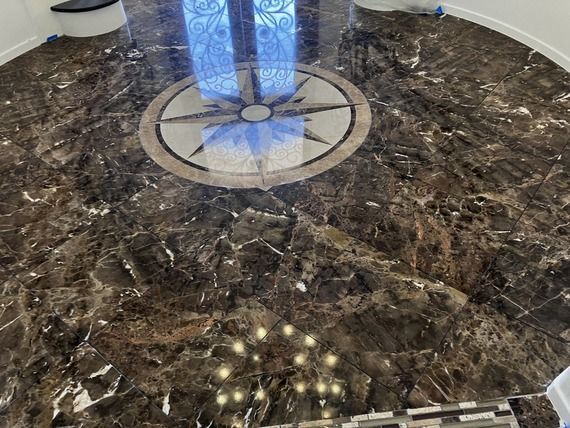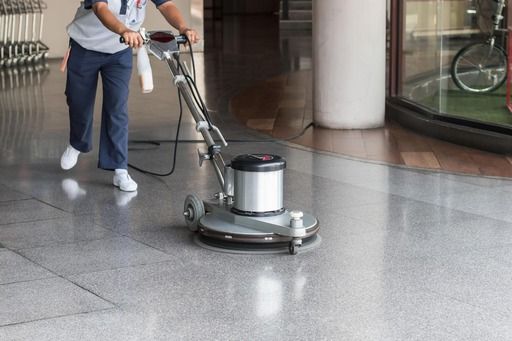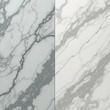Marble Polishing Guide: How to Restore Shine to Your Marble Floors and Countertops
Marble floors and countertops add a luxurious touch to Los Angeles homes, but even the most beautiful marble can lose its shine without proper care.
Over time, everyday wear – from sand and dust to acidic spills – can scratch or etch marble’s surface, making it look dull.
Marble is a relatively soft, porous and natural so spills of juice or vinegar can chemically erode its polish, and grime can settle into tiny pores and scratches.
In this guide, we’ll explain why marble dulls over time, the benefits of professional marble polishing, and give you a step-by-step polishing process.
We’ll compare DIY polishing tips vs. professional service, cover how to maintain polished marble at home, and tell you when it’s time to schedule a marble polishing service. Los Angeles homeowners will find these tips especially useful for keeping their Southern California marble sparkling. For expert help, Famous Marble Restoration in Los Angeles can bring back your marble’s showroom shine.

Why Marble Loses Its Shine Over Time
Marble is formed from limestone under intense heat and pressure, but even so it remains a relatively soft stoneparamountstone.co.uk. This softness, combined with its natural porosity, means marble easily shows wear. Small sand grains and grit can create micro-scratches on marble floors, and common household acids (like citrus juice or vinegar) can etch the polished surfaceparamountstone.co.uk. Over months and years, these tiny scratches and etch marks scatter light instead of reflecting it, so the stone looks lackluster. In fact, marble readily absorbs liquids, and stains can set in if spills aren’t cleaned quickly. Famous Marble Restoration notes that “Marble is a porous stone, making it prone to absorbing spills and stains” – regular cleaning is needed to “maintain the natural shine of the marble, preventing it from becoming dull. In short, foot traffic, cleaning mistakes, and environmental factors all contribute to a gradual loss of marble’s glossy finish.
Benefits of Professional Marble Polishing
- Removes Deep Scratches and Etches: Professionals use diamond abrasive pads and industrial buffers to grind down imperfections that home methods can’t fix. These tools (ranging from coarse 30-grit to very fine 1500-grit pads) can eliminate scratches and etch marks, restoring a smooth surface.
- High-Gloss Finish: After honing the stone, expert polishing with finer grits produces a mirror-like sheen. As Rose Restoration explains, the stone is treated “using a series of diamond abrasive pads and powders, gradually creating the desired finish,” resulting in a high shine. This kind of deep gloss is hard to achieve with household polishers.
- Protective Sealing: Professional service includes sealing the marble after polishing. A quality penetrating sealer locks in the shine and blocks stains or etching from water and oils. Sealing extends the life of the finish, preventing new damage from scuffs or spills.
- Experienced Technicians: Skilled techs know the right products and techniques for your stone. The Famous Marble team prides itself on “extensive knowledge and expertise” with “the latest tools and technologies. They can safely adjust methods for different marble types and problem areas. DIY attempts often lack this precision and can leave uneven.
- Time and Convenience: Polishing large areas (like an entire floor) by hand is labor-intensive. Professionals have powerful equipment and achieve results much faster. As one cleaner notes, if marble is “plagued by deep stains, heavy scratches, or years of wear and tear,” professional help is often required to restore the shine. Hiring a pro saves you time and ensures a thorough job.
Step-by-Step Marble Polishing Process
- Clean and Prepare the Surface: Remove all dirt and debris. Sweep or vacuum the marble, then wipe it down with a clean microfiber cloth or mop. Use a pH-neutral marble cleaner to remove any residue – never use vinegar or acidic cleaners, which can further etch the stone. Rinse with water and dry completely.
- Grinding/Honing (if needed): If the marble is uneven or has deep scratches, the pro starts with coarse diamond pads (around 30–50 grit) on a floor machine. This grinding step levels the surface and removes the worst flaws. A coarser grind (up to 200 grit) may be used for heavy stains or lippage. At this point, the stone is honed flat and ready for finer polishing.
- Polishing with Finer Pads: Next, the technician switches to finer-grit diamond pads. Medium grits (400–800) smooth the marble further, and fine grits (1000–1500) bring out a deep shine. The machine is moved in overlapping passes across the floor or countertop until the entire surface is uniformly glossy.
- Buffing/Crystallization: For a final mirror finish, some pros use an ultra-fine pad or a crystallizing compound on a high-speed bufferin. This “buffing” step (sometimes called crystallization) applies a very fine 3000-grit or chemical treatment that makes the marble highly reflective. It can give the stone a brilliant, mirror-like finish.
- Sealing: The last step is to apply a high-quality marble sealer. A penetrating stone sealer is usually preferred, as it soaks into the pores and provides long-lasting protectionhardfloorrestoration.co.uk. As a good note, a good marble sealer should be applied “at least once every year” to extend the life of the polished floor.
Skilled technicians often use high-powered floor buffers (as pictured) equipped with diamond-impregnated pads to bring marble up to a lustrous shine. These machines operate at high speed to grind and polish the surface more effectively than household tools. Each rotating pad, along with polishing compounds, works through progressively finer grits to remove imperfections and reflect light beautifully. The result is a uniform, mirror-like finish that showcases marble’s natural elegance.
DIY Polishing Tips vs. Hiring a Professional
DIY Polishing Tips
- Daily Cleaning: Keep marble dust-free by sweeping or vacuuming regularlyhardfloorrestoration.co.ukabbeyfloorcare.co.uk. Wipe up spills immediately with a soft cloth to prevent stains or etches. For routine cleaning, use warm water with a few drops of mild soap or a specially formulated marble cleaner – always test on a small area first. Remember: never use vinegar or lemon juice on marble, as one FAQ warns, “its acidity can etch the surface”abbeyfloorcare.co.uk.
- Light Polishing: For minor dull spots, you can try a marble polishing powder or paste (sold in home stores). Dampen the area and rub the powder in small sections with a soft cloth or a low-speed buffer pad, following package instructions. This may restore some shine to small areas without stripping off too much material.
- Gentle Buffing: After cleaning or applying polish, buff marble dry with a clean microfiber cloth. Soft cotton or a gentle buffing pad can help even out minor wear. Patience and light pressure are key – aggressive scrubbing can make scratches worseabbeyfloorcare.co.uk.
- Spot Treatments: For water spots or mild stains on countertops, mix a bit of water with a gentle cleaner (or hydrogen peroxide for light organic stains) and rub the spot with a soft clothabbeyfloorcare.co.uk. Always rinse thoroughly and dry.
DIY methods can be affordable and convenient, especially if your marble is only lightly faded. However, caution is needed: improper technique or harsh cleaners can make matters worseabbeyfloorcare.co.uk. As one expert notes, if your floors only have mild staining or dulling, regular gentle cleaning and occasional polishing might suffice. But for any deep scratches or stubborn etches, you risk uneven finishes or damage without professional expertiseabbeyfloorcare.co.uk.
Hiring a Professional
If your marble has deep stains, heavy scratches, or extensive dullness, hiring a pro is usually the safest bet. As noted above, “when marble floors are plagued by deep stains, heavy scratches, or years of wear and tear, professional assistance is required”. Professionals use powerful machines and high-grade compounds (often industrial diamond pads and crystallizers) that can fully revive worn marble. They also carefully inspect the stone first – if an area is too damaged, experts will recommend repair or refinishing instead of risky DIY fixesparamountstone.co.uk.
Hiring Famous Marble Restoration in Los Angeles means you get tailored solutions and peace of mind. Their trained technicians can ensure an even polish across all surfaces, and they know which sealer and finish best suit each marble type. If you find that regular cleaning and home polishing haven’t restored your floor’s glow, it’s time to “revive them” professionally – as one source advises, diamond polishing and sealing by a pro can safeguard the surface for years. In short, use DIY methods for light upkeep, but call in experts for serious restoration to avoid DIY fears like uneven results or worsened etching.
How to Maintain Polished Marble at Home
- Gentle Cleaning Routine: Make maintenance easy by cleaning consistently. Daily sweeping or vacuuming prevents gritty dirt from scratching marblehardfloorrestoration.co.ukabbeyfloorcare.co.uk. Mop at least weekly with a barely damp microfiber mop and a marble-safe cleaner (or a mild detergent in water). Abbey Floor Care suggests sweeping each morning and damp-mopping each evening to trap dust and spills before they cause harmabbeyfloorcare.co.uk. Always dry the surface completely; standing water can leave mineral spots or streaks.
- Use the Right Products: Stick to pH-neutral cleaners formulated for stone. Avoid ammonia, vinegar, lemon or any acidic/alkaline household cleaners. Famous Marble Restoration’s guidelines explicitly say to skip vinegar or lemon juice, since “its acidity can etch the surface”abbeyfloorcare.co.uk. After mopping, you can buff the marble lightly with a dry cloth for extra shine.
- Preventative Measures: Place mats or rugs at entryways to catch sand and dirt before it hits your marble floors. Use felt pads under furniture and potted plants to avoid scratches. Always use coasters under drinks and trivets under hot pans on marble countertops to guard against stains and heat damage. These simple steps reduce the need for polishing by keeping the marble surface intact.
- Periodic Polishing and Sealing: Even with careful cleaning, marble benefits from occasional polishing. You can periodically apply a marble polish (readily available in stores) to revive the luster and remove tiny abrasionshardfloorrestoration.co.uk. For example, some homeowners use a creamy marble polishing compound a few times a year to freshen the shine. More importantly, reseal your marble once or twice a year. A penetrating stone sealer protects against stains and etching – one guide notes that applying an impregnating sealer provides “an extra layer of protection against stains and spills”abbeyfloorcare.co.uk. Many experts recommend resealing polished marble about once a year.
- When to Call the Pros: If your regular care isn’t keeping the marble gleaming, plan on an annual professional tune-up. Even gorgeous marble, with proper cleaning, often needs expert polishing every 6–12 months. Abbey Floor Care recommends that low-traffic areas be polished about once a year to stay in top conditionabbeyfloorcare.co.uk. Making professional polishing part of your maintenance schedule will keep the marble’s luster long-term.
By following these maintenance tips, Los Angeles homeowners can extend the beauty of their marble surfaces between professional services. Remember: gentle care and the right products go a long way in preserving that polished brilliancehardfloorrestoration.co.ukabbeyfloorcare.co.uk.
When to Schedule Marble Polishing Services
- Based on Usage: High-traffic areas (entry halls, kitchens) naturally wear faster. If your marble floor sees heavy daily traffic, consider professional polishing on the shorter end of the schedule. Abbey Floor Care notes that heavily used spaces may require more frequent polishing, while typical residential marble might only need service every 6–12 monthsabbeyfloorcare.co.uk. For most Los Angeles homes, once-a-year polishing keeps floors looking great.
- Visible Dullness or Damage: A key sign you need polishing is when cleaning and DIY efforts no longer restore the shine. If you mop and buff but the marble still looks foggy or scratched, schedule a pro. As a rule of thumb, when even “regular cleaning” won’t make the marble gleam, it’s time for expert help.
- After Home Projects or Stains: Consider polishing after any renovation work (which can kick up grout or acidic messes) or if a stubborn stain or etch has appeared. Pro polishing will remove construction haze or deep marks.
- Before Special Occasions: Many homeowners choose to re-polish marble before selling or hosting big events, to ensure the stone floors and countertops are their most impressive. A freshly polished marble floor really shows off a home.
If you’re unsure about timing, consult the professionals. Famous Marble Restoration can inspect your marble and recommend a schedule. As they advise, a well-planned polishing schedule tailored to your stone will help it remain a “stunning centerpiece for years to come”abbeyfloorcare.co.uk. Don’t wait until the marble is completely matte – preventive polishing keeps it in prime condition.
Contact Famous Marble Restoration for a Quote
Ready to see your marble floors and countertops gleaming again? Famous Marble Restoration is your local Los Angeles expert in marble polishing and care. Our skilled technicians use proven techniques and high-quality products to revive the shine and protect your stone for the long haul. Whether you have a small dull spot or an entire marble foyer, we can handle the job. Contact Famous Marble Restoration today for a free estimate – we’ll guide you on the best solution for your marble and schedule a convenient polishing service in the Los Angeles area. Trust our friendly, professional team to restore the elegance of your marble and keep your home sparkling.


